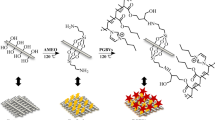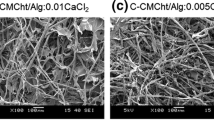Abstract
The purpose of the present work was to modify the absorbent cotton gauze to improve its functionality as antimicrobial wound dressing. The cotton gauze was modified by grafting of N-vinyl-pyrrolidone using microwave-assisted reactions. The effect of volume of N-vinyl-pyrrolidone and amount of ammonium persulfate on percentage grafting was optimized by 2-factor, 3-level central composite experimental design. The optimized batch of gauze-g-NVP was impregnated with iodine. The iodine-loaded gauze-g-NVP was characteristically examined by Fourier-transformed infrared spectroscopy and Field emission-scanning electron microscopy studies. The results of energy dispersive X-ray analysis confirmed the uniform dispersion of iodine on the surface of iodine impregnated poly(NVP)-g-cotton gauze. Further, the iodine-loaded gauze-g-NVP showed blood absorbency and in vitro blood clotting ability comparable to the absorbent cotton gauze. However, a significantly higher antimicrobial activity of iodine-loaded gauze-g-NVP against the Staphylococcus aureus and Escherichia coli was observed as compared to the iodine solution of equivalent concentration which can be attributed to the higher retention of iodine at the site of action. In the nutshell, results show that iodine-loaded grafted cotton gauze have the desirable and effective antibacterial wound dressing property with excellent blood absorbency and clotting abilities.
Similar content being viewed by others
References
S. Milovanovic, M. Stamenic, D. Markovic, M. Radetic, and I. Zizovic, J. Supercrit. Fluids, 84, 173 (2013).
J. I. Macha, M. M. Muna, and L. J. Magere, J. Drug Deliv. Sci. Tec., 43, 163 (2018).
K. M. Zahran, B. H. Ahmed, and H. M. El-Rafie, Carbohydr. Polym., 108, 145 (2014).
L. O. Shanmugasundaram, Indian J. Fibre Text., 37, 429 (2011).
G. M. Mehrabani, R. Karimian, R. Rakhshaei, F. Pakdel, H. Eslami, V. Fakhrzadeh, M. Rahimi, R. Salehi, and S. H. Kafil, Int. J. Biol. Macromol.116, 966 (2018).
A. M. Diez-Pascual and A. L. Dies-Vicente, Biomacromol., 16, 2631 (2015).
T. Maneerung, S. Tokkura, and R. Rujiravanit, Carbohydr. Polym., 72, 43 (2008).
F. Ferrero, M. Periolatto, C. Vineis, and A. Varesano, Carbohydr. Polym., 103, 207 (2014).
A. Lumbreras-Aguayo, I. H. Ortiz-Melendez, B. Urbina-Puente, C. Canche-Alvarado, A. Ledezma, J. Garcia-Romero, and R. Galindo-Betancourt, Carbohydr. Polym., 8, 205 (2019).
K. K. Ou, X. J. Wu, B. X. Wang, C. Meng, X. Dong, and J. X. He, Cellulose, 24, 5211 (2017).
Y. Qin, “Advanced Textile for Wound Car”, Chap.7, pp.195–197, China: Qingdao, 2019.
A.-N. Au-Duong, D.-T. Vo, and C.-K. Lee, J. Mater. Chem. B., 3, 840 (2015).
L. P. Bigliardi, L. A. S. Alsagoff, Y. H. El-Kafrawi, J.-K. Pyon, C. T. C. Wa, and A. M. Villa, Int. J. Surg., 44, 260 (2017).
M. Nesvadbvoa, M. Crosera, G. Maina, and L. F. Filon, Toxi. Lett., 3, 235 (2015).
J. C. Koerner, M. J. George, D. R. Meyer, M. G. Rosco, and M. M. Habib, Surv. Ophthalmol., 6, 63 (2018).
U. Yan, Y. Zhang, Q. Wang, H. Du, and L. Qiao, Appl. Surf. Sci., 363, 432 (2016).
K. Goswami and M. S. Austin, Arthroplast. Today, 5, 306 (2019).
A. S. Olson, L. Rosenblatt, N. Salerno, J. Odette, R. Ren, T. Emanuel, J. Michalek, Q. Liu, L. Du, K. Jahangir, and G. R. Schmitz, Int. J. Emerg. Med., 56, 405 (2019).
C.-M. Xing, J.-P. Deng, and W.-T. Yang, J. Appl. Polym. Sci., 5, 97 (2005).
B. Gao, Z. Wang, Q. Liu, and R. Du, Colloid Surface B, 2, 79 (2010).
Abhishek, Rimpy, and M. Ahuja, Int. J. Biol. Macomol.109, 732 (2018).
M. Ahuja, K. Thakur, and A. Kumar, Carbohydr. Polym.108, 154 (2014).
H. A. Beckett and B. J. Stenlake, “Practical Pharmaceutical Chemistry”, 3rd ed., Chap.7, pp.59–62, India: CBS Publishers and Distributers, 1975.
A. Brodio, J. Polym. Sci. Part A-2: Polym. Phys, 7, 1761 (1969).
W. Chan, H. C. Kim, X. Wang, H. S. Pun, J. N. White, and H. T. Kim, Acta Biomater., 31, 178 (2015).
BS EN 13726-I, “Aspects of Absorbancy, in: Test Methods, Primary Wound Dressings”, United Kingdom, 2002.
B. S. Gupta and J. V. Edwards, “Textiles Materials and Structures for Topical Management of Wounds”, Advanced Textiles for Wound Care, 2nd ed., pp.55–104 (2019).
K. Tashiro and M. Gakhutishvili, Polymer, 171, 140 (2019).
F. Nogueria, J. Vaz, C. Mouro, E. Piskin, and I. Gouveia, Biotechnol. Bioprocess. Eng., 3, 19 (2014).
R. Purwar, P. Rajput, and C. M. Srivastava, Fiber. Polym., 7, 15 (2014).
C. Chinkap, L. Myunghee, and K. C. Eun, Carbohydr. Polym., 12, 89 (2004).
F. Ferrero, C. Tonetti, and M. Periolatto, Carbohydr. Polym., 110, 367 (2014).
Author information
Authors and Affiliations
Corresponding author
Rights and permissions
About this article
Cite this article
Rashmi, Rimpy & Ahuja, M. Iodine Impregnated Poly(N-Vinylpyrrolidone) Grafted Antibacterial Cotton Gauze for Wound Dressing Applications. Fibers Polym 21, 1411–1421 (2020). https://doi.org/10.1007/s12221-020-9856-1
Received:
Revised:
Accepted:
Published:
Issue Date:
DOI: https://doi.org/10.1007/s12221-020-9856-1




